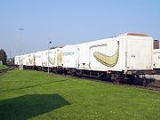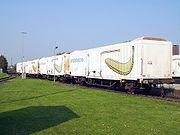
Refrigerated van
Encyclopedia

Goods wagon
Goods wagons are railway wagons that are used for the transportation of goods .- Development :At the beginning of the railway era, the vast majority of goods wagons were four-wheeled vehicles of simple construction. These were almost exclusively small covered wagons, open wagons with side-boards,...
with cooling equipment. Today they are designated by the International Union of Railways
International Union of Railways
The UIC , or International Union of Railways, is an international rail transport industry body.- Brief history :The railways of Europe originated as separate concerns. There were many border changes after World War I and the Treaty of Versailles. Colonial railways were the responsibility of the...
(UIC) as Class I
UIC classification of goods wagons
This list contains the UIC classification of goods wagons and their meanings. The description is made up of a class letter and usually several code letters ....
.
History
The first wagons were cooled with iceIce
Ice is water frozen into the solid state. Usually ice is the phase known as ice Ih, which is the most abundant of the varying solid phases on the Earth's surface. It can appear transparent or opaque bluish-white color, depending on the presence of impurities or air inclusions...
that had been cut in winter from special pools or lakes. It was Gustavus Swift who succeed in the winter of 1877 for the first time in developing an efficient cooling system for railway wagons for Chicago
Chicago
Chicago is the largest city in the US state of Illinois. With nearly 2.7 million residents, it is the most populous city in the Midwestern United States and the third most populous in the US, after New York City and Los Angeles...
businesses and meat producers. This enabled the circulation of air that through the ice and then the entire wagon in order to cool it down. This system was the basis of the success of the Union Stock Yard, the Chicago slaughterhouses. The cooled wagons made it possible for the first time to transport meat from slaughtered animals to the who of the USA. Later manufactured ice was used, but this rapidly gave way to other means of cooling; the simplest was the substitution of normal (water) ice by dry ice
Dry ice
Dry ice, sometimes referred to as "Cardice" or as "card ice" , is the solid form of carbon dioxide. It is used primarily as a cooling agent. Its advantages include lower temperature than that of water ice and not leaving any residue...
. With the increasing reliability of combustion engine
Combustion engine
Combustion engine may refer to:* Internal combustion engine* External combustion engine...
s, engine-powered refrigerator vans emerged. There are even vans whose cooling is achieved by the evaporation of liquid gas
Liquid gas
Due to the age of this content, you may be looking for:*Liquefaction of gases*liquid oxygen*liquid nitrogen*Liquid hydrogen*Liquid helium*paramagnetism *superconducting metals*ferromagnetism *liquified petroleum gas...
.
Construction
Compared with machine-cooled vans, ice-cooled wagons have the disadvantage of uneven temperature control, because the cooling effect is only achieved by air circulation. On the other machine-cooled wagons are expensive to maintain and operate, but can be set to the desired temperature and maintained at that temperature throughout the entire journey. They are also better suited for transporting goods at deep-freeze temperatures of around -30 °C, whereas evaporators and ice-cooling is more suited for temperatures around 0 °C. BananaBanana
Banana is the common name for herbaceous plants of the genus Musa and for the fruit they produce. Bananas come in a variety of sizes and colors when ripe, including yellow, purple, and red....
In addition to proper refrigerated vans there are covered wagons
Covered goods wagon
A covered goods wagon or van is a railway goods wagon which is designed for the transportation of moisture-susceptible goods and therefore fully enclosed by sides and a fixed roof. They are often referred to simply as covered wagons, and this is the term used by the International Union of Railways...
with thermal insulation and, in some cases, even those equipped with a refrigerating set. These wagens can only operate at temperatures between 0 °C and +20 °C, where a constant internal temperature is desired.
Use
In long-distance trains in the former Eastern Block countries, refrigerator trains were used that comprised a refrigeration plant wagon, a guards van and several refrigerated vans.Most food is transported by road nowadays due to the shorter journey times. The stock of refrigerated vans owned by railway companies has therefore shrunk considerably. Most refrigerated vans in Europe today are operated by Interfrigo. These wagons are easy to tell apart externally: white vans are normal refrigerated wagons, blue ones with white stripes along the side are machine-cooled refrigerator vans.
Types
Almost all refrigerated vans currently in service are built to UIC standard classes. The two-axled wagons have the same overall dimensions as the covered goods wagonCovered goods wagon
A covered goods wagon or van is a railway goods wagon which is designed for the transportation of moisture-susceptible goods and therefore fully enclosed by sides and a fixed roof. They are often referred to simply as covered wagons, and this is the term used by the International Union of Railways...
s of classes Gbs or Hbfs.
| UIC 571-3: Special classes | ||||
|---|---|---|---|---|
| Class | two-axle refrigerated vans | four-axle refrigerated vans | ||
| Standardwagen | Ferry wagons | 1st Variant | 2nd Variant | |
| Class UIC classification of goods wagons This list contains the UIC classification of goods wagons and their meanings. The description is made up of a class letter and usually several code letters .... 1) |
Ibbs / Ibbgs | Ibfs / Ibfgs | Ias / Iags | |
| Axle base | 8.00 m | − | ||
| Bogie Bogie A bogie is a wheeled wagon or trolley. In mechanics terms, a bogie is a chassis or framework carrying wheels, attached to a vehicle. It can be fixed in place, as on a cargo truck, mounted on a swivel, as on a railway carriage/car or locomotive, or sprung as in the suspension of a caterpillar... pivot pitch |
− | 15.80 m | 16.80 m | |
| Length over buffers | 14.02 m | 21.04 m | 22.24 m | |
| Loading length, min.1) | 10.50 m / 11.00 m | 16.40 m / 16.80 m | 17.80 m / 18.00 m | |
| Loading area, ca.1) | 27 m² / 28 m² | 23 m² / 24 m² | 42 m² / 43 m² | 45 m² / 46 m² |
| Unladen weight, max.1) | 15,5 t / 18.5 t | 31.0 t / 35.0 t | 32.0 t / 36.0 t | |
| Door height | 1.90 m | |||
| Door width | 2,70 m | |||
1) Refrigerated and insulated vans / Refrigerated vans with cooling equipment

